Ernesto Cesàro facts for kids
Quick facts for kids
Ernesto Cesàro
|
|
|---|---|
 |
|
| Born | March 12, 1859 Naples, Italy
|
| Died | September 12, 1906 (aged 47) Torre Annunziata, Italy
|
| Nationality | Italian |
| Education | University of Liège Sapienza University of Rome |
| Known for | Stolz–Cesàro theorem Cesàro equation Cesàro mean Cesàro summation Cesàro curve |
| Scientific career | |
| Fields | Mathematics |
| Institutions | University of Palermo University of Naples Federico II |
| Academic advisors | Eugène Charles Catalan |
Ernesto Cesàro (born March 12, 1859 – died September 12, 1906) was a brilliant Italian mathematician. He made important discoveries in a field called differential geometry. This part of mathematics looks at shapes and curves in a special way.
Cesàro wrote a book about his ideas. In this book, he described special shapes called fractals and space-filling curves. Some of these curves are still named after him, called Cesàro curves. He is also famous for a method he created to "average" numbers, known as the Cesàro mean.
A Mathematician's Life
Ernesto Cesàro's journey in academics had a tricky start. He traveled across Europe, spending important time in Liège, a city in Belgium. His older brother, Giuseppe Raimondo Pio Cesàro, taught about minerals at the university there.
Even before he officially graduated, Ernesto had already published many important works. Because of this, he became a member of the Royal Science Society of Belgium. He finally graduated from the University of Rome in 1887.
The next year, he became a professor of mathematics at the University of Palermo. He taught there until 1891. After that, he moved back to Rome. He became a professor at the Sapienza University and stayed there for the rest of his life. Sadly, he died in an accident while trying to save his youngest son, Manlio, from drowning.
Cesàro's Amazing Work
Cesàro's most important work was in differential geometry. This area of mathematics studies curves and surfaces using calculus. In 1894, he wrote a book called Lessons of Intrinsic Geometry. In this book, he explained how to create a special type of shape called a fractal curve.
He also studied other interesting curves, like the "snowflake curve" created by von Koch. This curve is continuous, meaning you can draw it without lifting your pencil. But it's also special because it's not smooth at any point.
Cesàro wrote several other important books. These include Introduction to the Mathematical Theory of Infinitesimal Calculus (1893) and Algebraic analysis (1894). He also wrote Elements of Infinitesimal Calculus (1897).
One of his most famous ideas is the "Cesàro sum." This is a way to find the average of numbers in a sequence. It helps mathematicians understand how some sequences behave, even if they don't seem to have a clear limit at first.
See Also

- In Spanish: Ernesto Cesàro para niños
- Stolz–Cesàro theorem
- Cesàro's theorem
- Cesàro equation
- Cesàro mean
- Cesàro summation
- Cesàro curve
- Lévy C curve

